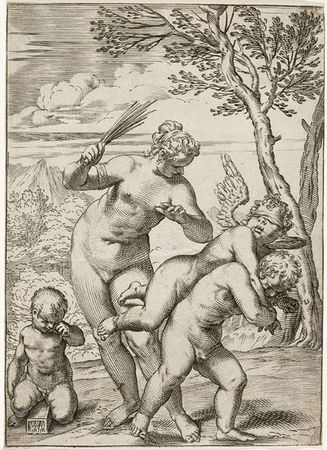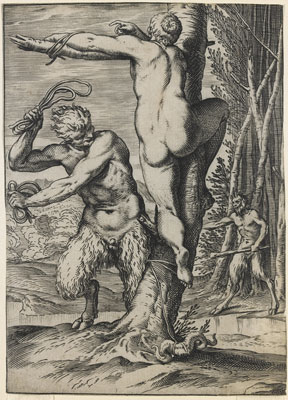Agostino Carracci
Agostino Carracci (✦1557 – †1602) was an Italian painter and printmaker. He was the brother of the more famous Annibale Carracci and cousin of Lodovico Carracci. Along with his brothers he was one of the founders of the Accademia degli Incamminati which helped propel painters of the School of Bologna to prominence.
Information from Catholic Encyclopedia
Agostino Carracci
An Italian painter, engraver, and etcher, b. at Bologna, 16 August, 1557; d. at Parma, 22 March, 1602. The son of Antonio Carracci, a tailor, he was nephew of Lodovico and brother of Annibale. He began his art life as a goldsmith; but, urged by his uncle, the youth abandoned plastic for graphic art, and studied painting, first with Fontana, who had been Lodovico's master, and later with Passerotti. The fame of Correggio's masterpieces drew Agostino to Parma, and afterwards, accompanied by Annibale, he made a long sojourn in Venice, where he became a distinguished engraver under the celebrated Cort. In 1589 he and his brother returned to Bologna and with Lodovico started the "School of the Carracci" (see below, LODOVICO), in which he taught while working devotedly at painting. In his native town is his masterpiece, "The Last Communion of St. Jerome", a beautiful work, showing Correggio's influence. Agostino helped in the decoration of nearly every great palace in Bologna, and his poetic imagination was of great avail when with the matter-of- fact Annibale he assisted in the decoration of the Farnese Palace in Rome. He was a poet, and an interesting sonnet of his tells the students of the "Academy" what parts to choose from each school of painting and from the masters of the past in order to attain perfection. In 1600 Annibale and Agostino had a disagreement, and the latter left for Parma, where for the rest of his life he painted for the duke. Agostino was a master of engraving: he introduced what is called "the large style", and the lines of his plates were broadly and boldly laid. His influence in the art of engraving was felt far beyond the bounds of Italy, and his technic with the graver was widely imitated. His plates were freely and beautifully executed, there is an admirable expression on all his faces, and the execution of the hands and feet is marvellous. In addition to his masterpiece, mention may be made of: "St Francis receiving the Stigmata" (Vienna); "Triumph of Galatea" (London). Among his numerous plates the best and most celebrated are: "Antonio Carracci" (his father); "Tiziano Vocelli"; "The Repose in Egypt".
- from the Lascivie (1590-1595).
Erotic art
Agostino Carracci is the creator of a famous set of erotic engravings that illustrate a wide variety of sexual techniques and positions. See "I Modi" on Wikipedia for more information and images.
In c. 1590-1595 Agostino Carracci created a set of erotic prints known as the "Lascivie". These contain spanking art, as follows:
- Vênus punindo Eros (English title: Venus Punishing Profane Love), a burin engraving in which Venus birches Eros (F/B, who is naked, blindfolded and horsed for his punishment by another boy (or erote).
- "Satyr Whipping a Nymph", also known as "Satyr flogging a Nymph".
See also
Links
Chat rooms • What links here • Copyright info • Contact information • Category:Root

